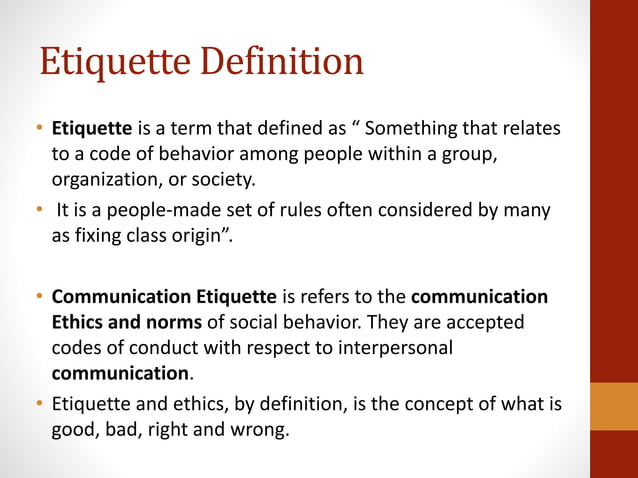- Describe the purpose of the rules of etiquette
- 10 golden rules of email etiquette
- 5 rules of golf etiquette
Rules of fence etiquette
Time is a shared resource and how your employees manage it sends a clear message about their professionalism. Being punctual isn’t just a nice-to-have trait; it’s a core part of work etiquette https://assisesletrot2020.com/. It demonstrates respect for others’ schedules and keeps workflows running smoothly.
In busy work environments especially where communication is fast and frequent common courtesies often get overlooked. With quick chats, rapid emails, and virtual meetings becoming the norm, simple gestures like saying “please” and “thank you” can easily get lost in the rush. This subtle decline in everyday manners can unintentionally create friction or leave colleagues feeling undervalued.
Workplace etiquette is more than just common courtesy — it’s the glue that holds teams together. It shapes how employees interact, resolve conflict, represent the organization, and contribute to a collaborative culture. In today’s hybrid and often global workplaces, it’s essential to incorporate workplace etiquette into employee training and development.
Describe the purpose of the rules of etiquette
World wars and increasing social equality resulted in a simpler code, appropriate to the faster tempo and less pampered conditions of life in society. Nonetheless, etiquette remains active on royal or ceremonial occasions and in the more formal aspects of professional or communal life. No rule of law or principle of morality decrees that a soup plate should be tilted away from, never toward, the diner, or that (in Great Britain) a surgeon shall be known as “Mr.” while a physician is addressed as “Dr.,” but etiquette ordains it. Since the framework and content of the communities of which society is formed are constantly changing, the habits of etiquette can and do change with them.

World wars and increasing social equality resulted in a simpler code, appropriate to the faster tempo and less pampered conditions of life in society. Nonetheless, etiquette remains active on royal or ceremonial occasions and in the more formal aspects of professional or communal life. No rule of law or principle of morality decrees that a soup plate should be tilted away from, never toward, the diner, or that (in Great Britain) a surgeon shall be known as “Mr.” while a physician is addressed as “Dr.,” but etiquette ordains it. Since the framework and content of the communities of which society is formed are constantly changing, the habits of etiquette can and do change with them.
You take a cab, hoping for a friendly smile, but are instead met with a dismissive eye roll from the driver. Finally, you arrive at the office, only to find that half of your colleagues either don’t make eye contact when they greet you or, worse, don’t bother to say hello at all, too absorbed in scrolling through their phones.
Etiquette serves as a preventive measure against conflict. When people observe polite and respectful behavior, misunderstandings and disputes are less likely to arise. Whether in family gatherings, business negotiations, or public spaces, adhering to established etiquette norms can help prevent confrontations and promote a peaceful coexistence.
However, as soon as you leave your apartment, a neighbor with an angry face approaches you. Without even a greeting, they launch into a tirade about the poor maintenance of the building. Once you escape that conversation and head down the street, it feels as though you have entered a jungle: people in a rush, shouting loudly on their phones, gesturing wildly with their earphones in, bumping into each other with shoulders, handbags, and umbrellas, all without even noticing one another.
Etiquette, often referred to as the code of polite behavior, is a set of rules and customs that govern social interactions. While it may seem like a relic of the past, etiquette remains highly relevant in our modern society. In this article, we will explore the enduring importance of etiquette and why it plays a crucial role in our lives.
10 golden rules of email etiquette
Email etiquette is at the top of most people’s list (of those who use it, and that includes almost everyone) of Pet Peeves. While we can’t expect others to listen to our instruction about how to use it properly, as an etiquette expert, I am stating 10 simple facts. There are many more, but we’ll start here.
Ensuring correct spelling of the recipient’s name, avoiding spelling errors, using simple sentence structures, and maintaining proper capitalization and punctuation are crucial for maintaining professionalism and credibility in your emails.
Never ever send an angry email, or give a quick, flip response. Give your message some thoughtful consideration before sending it. If you feel angry, put your message into the “drafts” folder, and review it again later when you are calmer and have time to formulate an appropriate response.
Reducing errors in your emails is essential for presenting your business as professional, detail-oriented, and credible. By avoiding grammatical and spelling mistakes, you demonstrate diligence and maintain a polished image that instills confidence in your recipients.
5 rules of golf etiquette
Regarding golf etiquette, one of the most important rules is to avoid using your phone or other electronic devices while on the course. As technology continues to become more and more a part of our lives, it can be tempting to use your phone while playing golf. However, this is something that should be avoided at all costs.
I’ve noticed more and more people not caring about their shadow on the green, and new players letting it slide because they don’t know that this is a common courtesy. Keep your shadow clear of your playing partner’s body, target, and line of sight.
Golfers should always attend the golf course at least fifteen minutes early. This gives them enough time to check in with the staff and have a few moments to practice before they get started. Showing up early also helps golfers remain relaxed as they begin their round of golf, which is essential for playing a good game.
Ready golf should be the go-to method when playing a round of golf. It is designed to speed up the game and can have a positive impact on your score as well. Playing ready golf means that each golfer should be prepared to hit their bad shot as soon as it’s their turn, without any delays or waiting for someone else to play. This not only saves time but also helps to keep everyone in the same rhythm throughout the game.
When playing rounds of golf with friends, many people are tempted to shoulder their clubs and leave their bags on the tee box. This means that other golfers behind them must find a spot to place their bags, which can be difficult and distracting. Having bags in the way of someone’s striking vision can also interfere with their ability to play a good shot.


